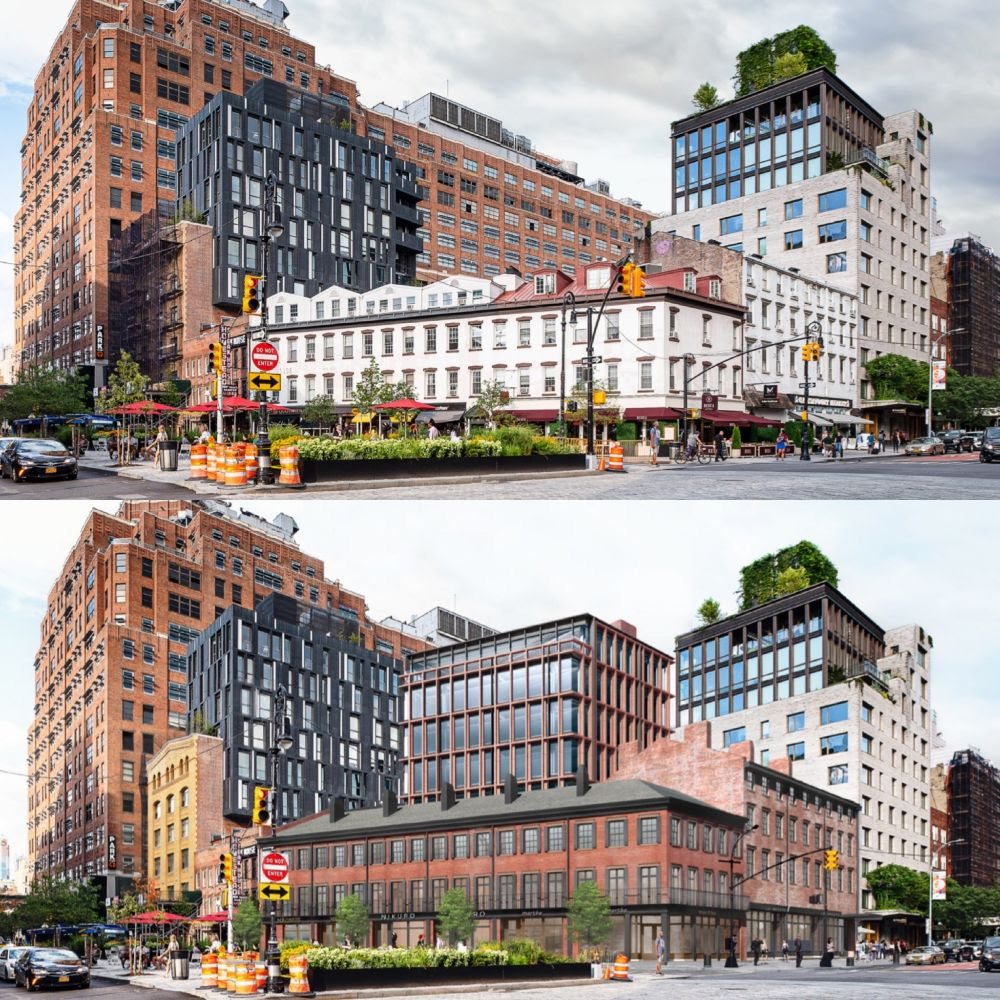BY THE VILLAGE SUN | Updated Oct. 9, 10 p.m.: In shocking news, the city has ordered the near-complete demolition of nine landmark buildings on the northeast corner of 14th Street and 9th Avenue in the Gansevoort Market Historic District. However, the Department of Buildings says the facades must then be rebuilt using the original material.
Last year, a developer sought permission to demolish all but the facades of these buildings to allow a tower to be built behind and attached to them. At the time, Village Preservation, Community Board 4 and local politicians all strenuously objected to the scheme.
After significant pushback, the city’s Landmarks Preservation Commission required that a larger portion of the buildings’ exteriors be preserved, plus reduced the size and modified the design of the proposed new building behind the historic 1840s houses.
Tavros is the developer of the project.
After work started, however, it was found that the buildings’ facades were at risk of collapse. D.O.B. ordered that the facades of all nine buildings be demolished and that the party walls, or walls between the row houses, be shored up on an emergency basis. A D.O.B. spokesperson said the developer has been told to preserve the material from the demolition and reuse it to rebuild the facades.
Village Preservation has challenged this decision and questioned the actions of the developer, D.O.B. and the Landmarks Preservation Commission that allowed this stunning situation to unfold.
Specifically, on Oct. 4, Andrew Berman, Village Preservation’s executive director, wrote a letter to Mayor de Blasio, L.P.C. Chairperson Sarah Carroll and D.O.B. Commissioner Melanie La Rocca on what he called the “extremely disturbing news” about the nine buildings.
These buildings, described in the [L.P.C.] designation report for the Gansevoort Market Historic District as “a picturesque ensemble at the wide, angled intersection of West 14th and Hudson Streets and Ninth Avenue” and “rare surviving examples of 1840s pitched-roofed row houses in Manhattan,” have long stood as a symbol and anchor of the Gansevoort Market Historic District, Berman wrote.
“We specifically objected to the degree of destruction of the historic material of the existing landmarked buildings, noting it made a mockery of the purpose of landmark preservation,” he added. “Now, as we understand, the work to achieve this approved level of destruction has resulted in the undermining of the structural integrity of the remaining sections of the buildings, requiring their destruction as well. Clearly, something went very seriously awry here, and it’s imperative that those responsible be held to account.”
Village Preservation is demanding that the buildings be shored up and allowed to remain standing, if it can be done safely. Should the buildings be too severely compromised, then as much of their historic fabric as possible should be preserved and used in the buildings’ reconstruction, the group says.
In his letter, Berman also demanded that the city agencies and the developer “be held to account” for their part in either allowing or causing this situation to happen.
“If the owner performed illegal work, or filed misleading, false or inaccurate plans, they should be held responsible to fullest extent allowable by law,” Berman wrote. “However, if these city agencies approved plans for extensive alteration and deconstruction of landmarked buildings without properly examining whether or not such work could be performed safely and consistently with maintaining the parts of the buildings which were supposed to be preserved — their facades, roofs and most of their rears, as well as certain side walls — then these city agencies are responsible for this tragic situation. Under any circumstances, it’s hard to imagine how these two agencies were not derelict in their duties of oversight in allowing this situation to come to pass.”
In the worst-case scenario, if the existing buildings cannot be saved, then it should be required that their historic materials be saved and used to recreate a “faithful reconstruction,” he added.
The preservationist concluded his letter by saying, “And the Landmarks Preservation Commission should end its anti-preservation practice of allowing demolition of all but the facades or parts of the shells of buildings.”


I think it is clear that de Blasio has put the nail in the coffin on the LPC — it no longer functions as anything but a tool of the real estate industrial complex of our city. We need huge reforms to fix this.